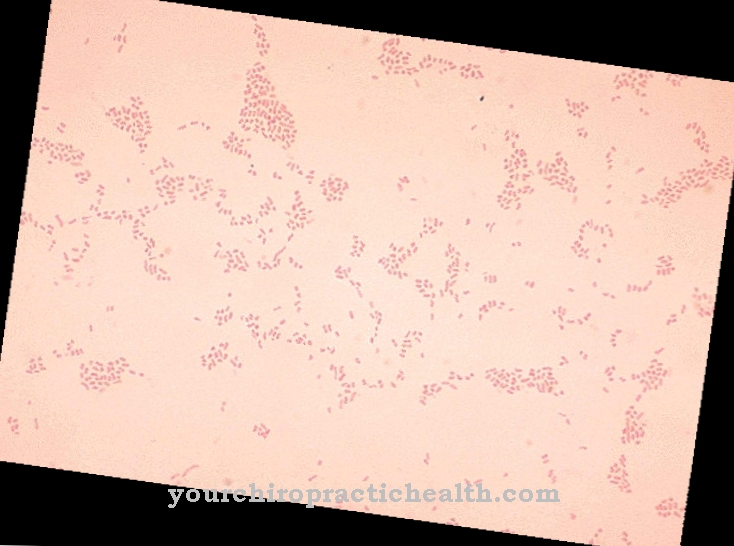Mycoplasmataceae is the family parent of the bacterial genus Mycoplasma and Ureaplasma. It is a series of types of bacteria that are noticeable for their lack of a cell wall and a pleomorphic shape.
What are Mycoplasmataceae?
The family of the Mycoplasmataceae belongs to the class of the Mollicutes and the order of the Mycoplasmatales. Mycoplasmataceae is the only family of the order Mycoplasmatales and includes the bacterial genera Mycoplasma and Ureaplasma.
Misunderstandings and definition errors often arise from the use of the generic term "mycoplasma" for the class of Mollicutes. If the class of the mycoplasma is mentioned, the class of the mollicutes is referred to here and not the genus of the mycoplasma.
The class of the Mollicutes, the order of the Mycoplasmatales and the family of the Mycoplasmataceae define a number of bacterial species for which a missing cell wall and a pleomorphic shape are characteristic.
Due to the lack of a cell wall, mycoplasmas or mollicutes have no flagella or other means of independent locomotion. They are dependent on amino acids and nucleic acids from other cells and can only survive through parasitism.
The names "Mollicutes", ie "the soft-skinned" and "Mycoplasma", ie "similar to the shape of fungal threads", already indicate the cell wallless shape and the pleomorphic properties.
Bacteria of the Mycoplasmataceae family have a size of 200-300 nanometers and are gram-negative due to the lack of a cell wall. They play a role as laboratory contaminants due to their small size. Since sterile filters are only produced serially up to a pore density of 220 nanometers, contamination by germs of the Mycoplasmataceae family can only be prevented with great difficulty.
The first Mycoplasmataceae were isolated in 1898 from cattle suffering from lung disease. In human medicine, the first pathogens were not isolated from patients with unspecific urinary tract infections until 1937 and called Mycoplasma hominis.
The Mycoplasma pneumoniae was isolated as a causative agent for atypical infections in the 1940s of the twentieth century. The classification of the various species in the Mycoplasmataceae family was established in 1955 by E.A. Made friends.
Occurrence, Distribution & Properties
Since mycoplasma and ureaplasma have no flagella or other forms of independent locomotion, they are dependent on being transmitted via body secretions and are mainly located in the urogenital tract and in the lungs. In women, the Ureaplasma urealyticum can settle in the normal urogenital flora unnoticed.
Mycoplasmataceae parasitize either intracellularly or extracellularly and thereby trigger a number of inflammatory processes, some of which can have serious consequences. Mycoplasma and ureaplasma are considered pathogens because of their parasitic way of life and the associated diseases. They are responsible for numerous inflammatory diseases in veterinary and human medicine.
Illnesses & ailments
In human medicine, the types Mykoplasma pneumoniae, Mykoplasma genitalium and Ureaplasma urealyticum are particularly prominent. Mycoplasma pneumoniae can cause numerous diseases of the respiratory tract and nervous system. Mycoplasma is known as the trigger for atypical pneumonia. But it can also be responsible for tracheobronchitis, i.e. inflammation of the bronchi in both acute and chronic manifestations, and pharyngitis, i.e. inflammation of the pharynx.
The pathogen can cause severe diseases in the central nervous system. Meningitis or meningitis can lead to lethal consequences or lifelong damage if treated in a timely manner. Sequelae such as epilepsy, hearing loss and cognitive disorders are common after meningitis.
The mycoplasma genitalium can cause non-gonoccocal urethritis. Non-gonococcal urethritis is an inflammation of the urethra that was not caused by gonococci. The urethritis caused by mycoplasma genitalium can spread to different areas of the pelvis in women and, if left untreated, lead to infertility. Other serious illnesses that followed, such as ovarian cancer, were observed, but to this day they have not been directly linked to the infection.
The Ureaplamsa urealyticum settles in the lower genital tract of women and can also occur in the normal urogenital flora. Ureaplasma urealyticum can cause serious infectious diseases in newborns. Ureaplasma can infect the embryo or infant during pregnancy and at birth. Early infection from the mother can cause pneumonia and neonatal sepsis in the infant.
In neonatal sepsis, the infant is born with an ongoing infection that spreads to the bloodstream. About 5% of child under 5 deaths worldwide are due to newborn sepsis.
By taking antibiotics a problem-free healing of the various diseases can be guaranteed up to now. The exact identification of the pathogen through smears, antibody measurements and PCRs is very important. Since antibiotics of the penicillin group attach to the cell wall of the bacteria and Mollicutes do not have a cell wall, pathogens of the Mollicutes group can show a natural resistance here. There are observations in which the ingestion of penicillin even led to the persistence of the cell wallless germs.
Antibiotics from the group of macrolides are generally recommended, as these start in the interior of the germ during protein synthesis and prevent further replication of the germ. Treatment with azithromycin or erythromycin is very promising for the proper convalescence of the patient.
In no case should antibiotics be prescribed out of pure suspicion, but first a clarification should take place taking into account laboratory medical findings in order to prevent persistence of the pathogen and the build-up of resistance in other germs.

























.jpg)


